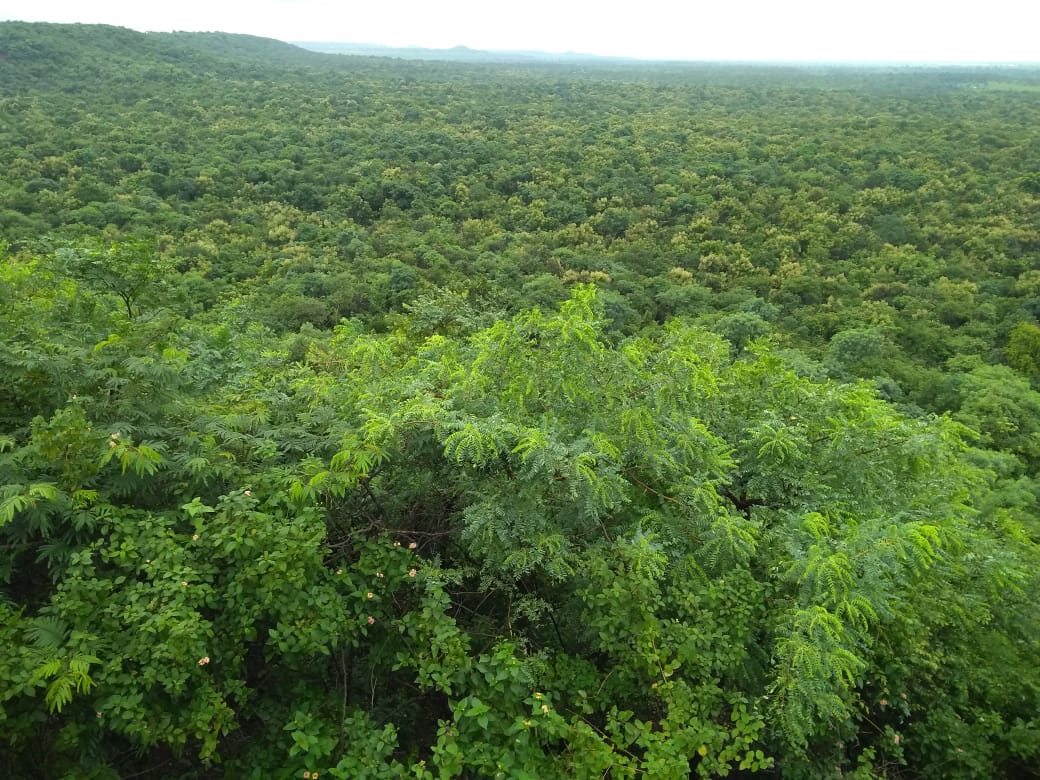The Indian Navy plans to set up a VLF radar facility in the Damagundam forest area at a cost of ₹2,500 crore. The forest is home to 12 lakh trees, 300 spotted deer, wolves, Nilgai, wild boar, sambar, Indian gazelle, and countless bird species.
Published Sep 22, 2024 | 7:00 AM ⚊ Updated Sep 22, 2024 | 7:00 AM

Damagundam Reserve Forest in Vikarabad is home to a rich diversity of flora and fauna. (Adv Spandana Reddy/X)
After the darshan at Damagundam Ramalingeshwar Swami Temple, a group of friends and I wanted to meet Satyananda Swamiji at the nearby ashram, as planned.
Swamiji had migrated from Kerala to Puduru village, 70 kilometers from Hyderabad, in 1980. We got his phone number with the help of villagers and spoke to him before proceeding to the ashram at the specified time. The ashram does not mean a vast, sprawling space spread over hundreds of acres, and bustling with people: it’s just a small two-room house on two acres.
The Swamiji, draped in saffron robes, walked halfway to welcome us.
As expected, he appeared to be over 50 years old, radiating the kind of brilliance that comes with profound knowledge, draped in his saffron robes.
“What do you want?” he asked. We requested to speak about the Damagundam forest, the central government’s planned Very-Low Frequency (VLF) radar station, the local flora and fauna, the displaced people, and the potential benefits and losses.
“Don’t you need the forest?” His direct words struck a chord with us.
We were all silent for a moment.
His words flowed like a stream — clear and refreshing.
Swamiji explained that a single tree produces one lakh liters of oxygen each year, and cutting down 12 lakh trees for the radar station would cause immense damage to the environment.
He expressed grave concern that if Damagundam — the lifeline of the Musi River — isn’t protected, the groundwater, down to a depth of 2,800 meters, will become polluted. The impact won’t just be felt in Hyderabad but across the entire Telangana, affecting its people, resources, and health.
The Damagundam forest is rich in biodiversity, home to 12 lakh trees, 300 spotted deer, wolves, Nilgai, wild boar, sambar, Indian gazelle, and countless bird species. The forest is also renowned for its rare medicinal plants.
Many environmental organisations, villagers, and activists are opposing the radar station, which is being planned in the Damagundam Reserve Forest in Puduru Mandal of the Vikarabad district. Out of the total 2,900 acres, 1,400 acres are allocated for Antenna Park, 1,090 acres for the Technical Area, 310 acres for offices, and 100 acres for a Safe Zone.
The Indian Navy plans to set up a VLF radar facility in the Damagundam forest area at a cost of ₹2,500 crore. This project was proposed 12 years ago, but for nearly a decade after Telangana’s formation, the KCR government did not cooperate. However, once the Congress government assumed office, the project gained momentum.
Swamiji shared that the local people have already begun efforts to protect the forest lands with the slogan “Save Damagundam.” Recently, the National Alliance of People’s Movements urged Chief Minister A Revanth Reddy to drop the idea of handing over the Damagundam forestland to the Navy.
When asked if people were organising against the project, Swamiji replied, “Some people are innocent. They believe the temporary promises of politicians. They’ve been promised markets, schools, jobs, and a 27-kilometer road—all within a few acres. How realistic are they?” he asked with a tinge of resignation.
His eyes became moist as he shared that he would soon sell his two acres and leave this place forever.
Yet, without showing too much emotion, he expressed a small hope: “You all should help. If we protest together, maybe by forming a human chain, the government, the judiciary, and the Navy will understand our pain and reconsider this project.”
Seeing a man from Kerala, with no direct connection to this soil or its people, care so deeply for the future of this land stirred a sense of guilt within us.
Finally, after hearing his words, “Damagundam Pote Yamagandam” (the loss of Damagundam will be a disaster), we bowed to this great man with heavy hearts and bid goodbye.
I hope that the people’s struggle against this Navy radar project, which threatens to destroy lakhs of rare trees, medicinal plants, and wildlife in the Damagundam forests, will succeed.
(Swarna Kilari is a writer, translator, and traveller. Views are personal. Edited by Majnu Babu).
